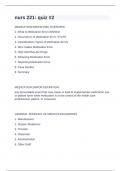Resume
Strategic Innovation Management: Summary + Class notes (MBA - KUL Brussels)
- Établissement
- Katholieke Universiteit Leuven (KU Leuven)
ENGLISH SUMMARY FOR MBA PROGRAM at KUL Prof.: Teirlinck Peter Textbook: Innovation Management and New Product Development (3423), Paul Trott This document contains a summary of the course content + class notes Course content: Part 1: INNOVATION MANAGEMENT - Innovation management: introduc...
[Montrer plus]













